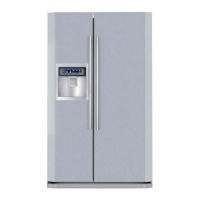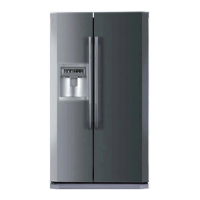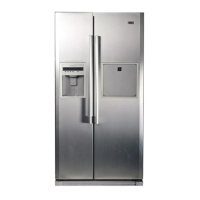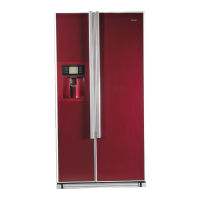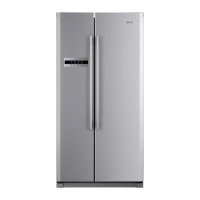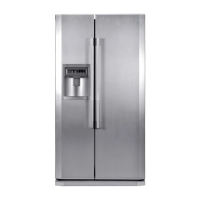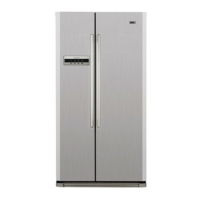Do you have a question about the Haier HRF-663BSS and is the answer not in the manual?
Automatic ice maker, powerful ice crusher, and refrigerated water dispenser.
Convenient storage for drinks, accessible without opening the main door.
Adjustable shelves and baskets for easy storage and cleaning.
Developed according to customer wishes for space-saving design.
Equipped with a user-friendly frost-free system for quick and even freezing.
Allows temperature adjustment prior to the defrosting cycle.
Indicates potential issues automatically.
Alerts when the door is left open or not closed properly.
Automatically adjusts temperature based on ambient conditions.
Identifies parts within the freezer section.
Identifies parts within the refrigerator section.
Guidelines for handling the power cord and plug to avoid damage.
Warnings regarding the presence of flammable substances.
Instructions for safe electrical connection and usage.
Avoid placing flammable, explosive, or corrosive materials inside.
Do not store fuel or other flammable products near the appliance.
Keep children away from climbing or hanging on doors.
Do not place microwave ovens or voltage regulators on the appliance.
Avoid fingers in door cracks and keep children away from doors.
Do not pour water on the appliance or place it in wet areas.
Only qualified professionals should repair or alter the appliance.
Do not store bottles and cans in the freezer; they may burst.
Unplug during power outages, repair, or cleaning.
Remove doors and shelves when disposing to prevent child entrapment.
Remove all packing material and check included accessories against the list.
Set up the appliance in a suitable area, ensuring level footing.
Attach the toe moulding to the refrigerator and freezer doors.
Step-by-step guide for installing the door handle.
Detailed instructions for assembling the refrigerator and freezer door handles.
Recommendation to clean the interior before starting up the appliance.
Allow the appliance to stand for at least six hours after cleaning before operation.
Instructions for removing the refrigerator door if the house door is too narrow.
Step to remove the toe moulding and release the water coupler.
Instructions for removing the freezer compartment door.
Instructions for removing the refrigerator compartment door.
How to slide the refrigerator through the door opening.
Steps to reinstall the doors by reversing the removal process.
Ensure a flat and level setup location with sturdy supports.
Protect the setup location from direct sunlight or heat sources.
Avoid damp setup locations and clean with a soft cloth.
Ensure adequate space around the appliance for ventilation.
Connect the appliance to power; it will automatically set to Intelligent/Crushed Ice modes.
Choose between Intelligent mode (recommended) and Manual mode.
Load food after the refrigerator has sufficiently cooled down.
Identifies buttons and indicators on the control panel.
How to activate and cancel the Intelligent mode.
What to do in case of major or minor control malfunctions.
How to activate the Superfrost function for quick freezing.
Detailed steps for adjusting refrigerator and freezer temperatures.
The buzzer sounds intermittently when the door is left open.
The display turns off 30 minutes after the last operation.
How to deactivate and reactivate the refrigerator using the control panel.
Use for short-term storage; temperature is 0°C-10°C, not for long-term storage.
Shelves are height-adjustable to accommodate various item sizes.
Instructions for adjusting and cleaning the bottle rack.
Examples of food grouping by temperature ranges within the compartment.
Steps to remove the vegetable drawer cover for cleaning.
Adjust humidity level for optimal storage of fruits and vegetables.
Instructions for replacing the light bulb in the refrigerator compartment.
Allow warm foods and drinks to cool to room temperature before storing.
Wash and dry fresh foods before placing them in the compartment.
Pack and seal foods to prevent drying and odor dissipation.
Pack food in portions suitable for household use.
Do not overstock the refrigerator; ensure space between items.
Remove leaves of root vegetables to prevent nutrient absorption.
Thawing frozen foods inside the refrigerator conserves energy.
Lists items like onions, peppers, garlic, and ginger that don't need refrigeration.
Lists items like gourds, melons, bananas, pineapple that decompose faster.
Press the compartment button to open the bar; light turns on when open.
You can place drinks and other foods in the home bar.
The home bar will not operate if the cover is removed.
Keep children away from the home bar to prevent injury or damage.
Use for long-term storage; low temperature is necessary.
Instructions for removing and cleaning glass shelves in the freezer.
Instructions for replacing the light bulb in the freezer compartment.
Instructions for adjusting and cleaning the bottle rack.
Allow foods and drinks to cool before placing them in the freezer.
Package food securely to prevent drying and odor contamination.
Write content and freezing date on packages; do not exceed storage time.
Remove only the required amount to be thawed.
Never place more fresh food than the maximum freezing capacity.
Connect the ice maker to a water supply line or water container.
Details on water supply line installation and pressure requirements.
Information regarding water pump connection and operation.
Safety guidelines regarding water temperature and operation.
Details on the ice cube production cycle and capacity.
Press the middle section to remove the ice cube container.
Slide the container into the channel until it latches.
Press button and lever for crushed ice dispensing.
Press button and lever for ice cube dispensing.
Press button and lever for refrigerated water dispensing.
Safety guidelines for using the dispenser, including cup height and hand safety.
The appliance defrosts automatically.
Regularly clean the refrigerator to prevent odors and maintain hygiene.
How to keep food cool during a power outage.
Steps to take when leaving the appliance idle for a long period.
Prepare the appliance before going on a long vacation.
Instructions for safely transporting the appliance.
Descriptions of normal sounds during initial operation and use.
Sounds that may occur during initial start-up or operation.
Normal sounds from refrigerant flow through evaporator and compressor.
Audible sounds produced by the fan during operation.
Evaporator lines may produce audible sounds when temperature changes.
Wipe off condensation from exterior housing with a soft cloth.
Confirm specific information before requesting a repair.
Troubleshooting steps if the unit is not cooling.
Troubleshooting steps if the light is not on.
Troubleshooting steps for unusual noises from the appliance.
Troubleshooting steps if the temperature is not cold enough.
Information on compressor operation during long periods or after initial use.
Normal conditions for frost/ice and how to avoid issues.
Causes and solutions for unusual odors inside the appliance.
Troubleshooting steps when the ice maker is not working properly.
Troubleshooting steps if the dispenser is not providing ice or water.
Troubleshooting steps if the dispenser mechanism is jammed.
Automatic ice maker, powerful ice crusher, and refrigerated water dispenser.
Convenient storage for drinks, accessible without opening the main door.
Adjustable shelves and baskets for easy storage and cleaning.
Developed according to customer wishes for space-saving design.
Equipped with a user-friendly frost-free system for quick and even freezing.
Allows temperature adjustment prior to the defrosting cycle.
Indicates potential issues automatically.
Alerts when the door is left open or not closed properly.
Automatically adjusts temperature based on ambient conditions.
Identifies parts within the freezer section.
Identifies parts within the refrigerator section.
Guidelines for handling the power cord and plug to avoid damage.
Warnings regarding the presence of flammable substances.
Instructions for safe electrical connection and usage.
Avoid placing flammable, explosive, or corrosive materials inside.
Do not store fuel or other flammable products near the appliance.
Keep children away from climbing or hanging on doors.
Do not place microwave ovens or voltage regulators on the appliance.
Avoid fingers in door cracks and keep children away from doors.
Do not pour water on the appliance or place it in wet areas.
Only qualified professionals should repair or alter the appliance.
Do not store bottles and cans in the freezer; they may burst.
Unplug during power outages, repair, or cleaning.
Remove doors and shelves when disposing to prevent child entrapment.
Remove all packing material and check included accessories against the list.
Set up the appliance in a suitable area, ensuring level footing.
Attach the toe moulding to the refrigerator and freezer doors.
Step-by-step guide for installing the door handle.
Detailed instructions for assembling the refrigerator and freezer door handles.
Recommendation to clean the interior before starting up the appliance.
Allow the appliance to stand for at least six hours after cleaning before operation.
Instructions for removing the refrigerator door if the house door is too narrow.
Step to remove the toe moulding and release the water coupler.
Instructions for removing the freezer compartment door.
Instructions for removing the refrigerator compartment door.
How to slide the refrigerator through the door opening.
Steps to reinstall the doors by reversing the removal process.
Ensure a flat and level setup location with sturdy supports.
Protect the setup location from direct sunlight or heat sources.
Avoid damp setup locations and clean with a soft cloth.
Ensure adequate space around the appliance for ventilation.
Connect the appliance to power; it will automatically set to Intelligent/Crushed Ice modes.
Choose between Intelligent mode (recommended) and Manual mode.
Load food after the refrigerator has sufficiently cooled down.
Identifies buttons and indicators on the control panel.
How to activate and cancel the Intelligent mode.
What to do in case of major or minor control malfunctions.
How to activate the Superfrost function for quick freezing.
Detailed steps for adjusting refrigerator and freezer temperatures.
The buzzer sounds intermittently when the door is left open.
The display turns off 30 minutes after the last operation.
How to deactivate and reactivate the refrigerator using the control panel.
Use for short-term storage; temperature is 0°C-10°C, not for long-term storage.
Shelves are height-adjustable to accommodate various item sizes.
Instructions for adjusting and cleaning the bottle rack.
Examples of food grouping by temperature ranges within the compartment.
Steps to remove the vegetable drawer cover for cleaning.
Adjust humidity level for optimal storage of fruits and vegetables.
Instructions for replacing the light bulb in the refrigerator compartment.
Allow warm foods and drinks to cool to room temperature before storing.
Wash and dry fresh foods before placing them in the compartment.
Pack and seal foods to prevent drying and odor dissipation.
Pack food in portions suitable for household use.
Do not overstock the refrigerator; ensure space between items.
Remove leaves of root vegetables to prevent nutrient absorption.
Thawing frozen foods inside the refrigerator conserves energy.
Lists items like onions, peppers, garlic, and ginger that don't need refrigeration.
Lists items like gourds, melons, bananas, pineapple that decompose faster.
Press the compartment button to open the bar; light turns on when open.
You can place drinks and other foods in the home bar.
The home bar will not operate if the cover is removed.
Keep children away from the home bar to prevent injury or damage.
Use for long-term storage; low temperature is necessary.
Instructions for removing and cleaning glass shelves in the freezer.
Instructions for replacing the light bulb in the freezer compartment.
Instructions for adjusting and cleaning the bottle rack.
Allow foods and drinks to cool before placing them in the freezer.
Package food securely to prevent drying and odor contamination.
Write content and freezing date on packages; do not exceed storage time.
Remove only the required amount to be thawed.
Never place more fresh food than the maximum freezing capacity.
Connect the ice maker to a water supply line or water container.
Details on water supply line installation and pressure requirements.
Information regarding water pump connection and operation.
Safety guidelines regarding water temperature and operation.
Details on the ice cube production cycle and capacity.
Press the middle section to remove the ice cube container.
Slide the container into the channel until it latches.
Press button and lever for crushed ice dispensing.
Press button and lever for ice cube dispensing.
Press button and lever for refrigerated water dispensing.
Safety guidelines for using the dispenser, including cup height and hand safety.
The appliance defrosts automatically.
Regularly clean the refrigerator to prevent odors and maintain hygiene.
How to keep food cool during a power outage.
Steps to take when leaving the appliance idle for a long period.
Prepare the appliance before going on a long vacation.
Instructions for safely transporting the appliance.
Descriptions of normal sounds during initial operation and use.
Sounds that may occur during initial start-up or operation.
Normal sounds from refrigerant flow through evaporator and compressor.
Audible sounds produced by the fan during operation.
Evaporator lines may produce audible sounds when temperature changes.
Wipe off condensation from exterior housing with a soft cloth.
Confirm specific information before requesting a repair.
Troubleshooting steps if the unit is not cooling.
Troubleshooting steps if the light is not on.
Troubleshooting steps for unusual noises from the appliance.
Troubleshooting steps if the temperature is not cold enough.
Information on compressor operation during long periods or after initial use.
Normal conditions for frost/ice and how to avoid issues.
Causes and solutions for unusual odors inside the appliance.
Troubleshooting steps when the ice maker is not working properly.
Troubleshooting steps if the dispenser is not providing ice or water.
Troubleshooting steps if the dispenser mechanism is jammed.
| Type | French Door |
|---|---|
| Defrost System | Automatic |
| Color | Stainless Steel |
| Ice Maker | Yes |
| Water Dispenser | Yes |
| Depth (in) | 34.8 |
| Height (in) | 70.1 |
